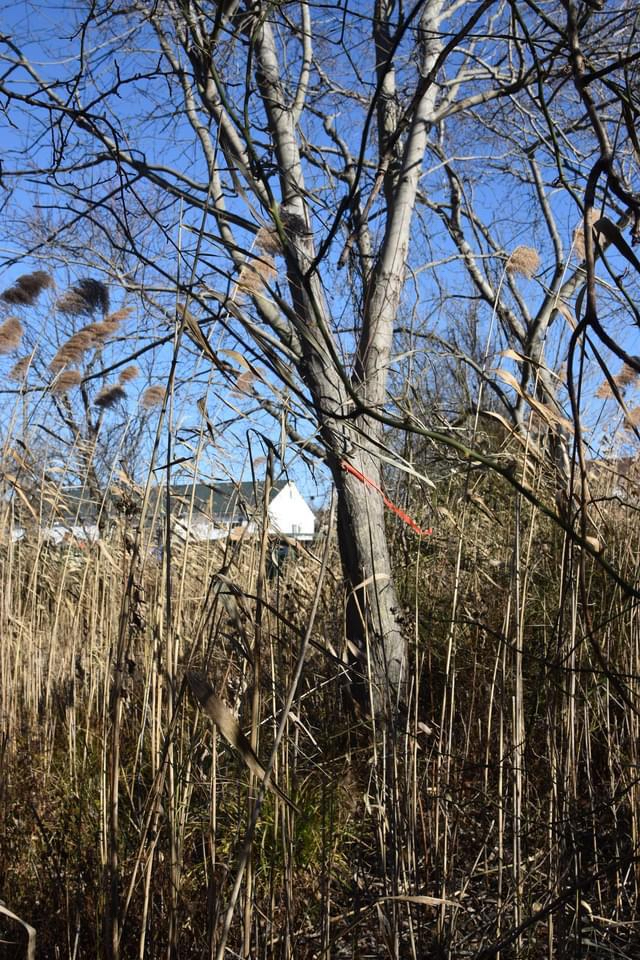By Chris Rotolo
MONMOUTH BEACH – A verbal sparring match between a local couple and opposing legal counsel used objections as jabs and the rule of law as body blows during a Feb. 22 planning board hearing for an application that proposes the development of three single-family dwellings on a parcel containing a patch of wetlands.
Following a public comment session that approached three and a half hours, and a short deliberation between the applicant, Monmouth Beach developers Mario Parisi and Patrick Golden and their attorney, Jennifer S. Krimko of Ansell Grimm & Aaron, PC, the audience of approximately 60 borough residents received the dramatic conclusion to a theatrical narrative they so greatly desired: compromise.
“I have a gift for you,” Parisi whispered to Michael-Ann Howley-Gatenby, who delivered a two-plus-hour presentation about the negative environmental impact of developing on or near what she and her husband Dave Gatenby referred to as “the borough’s sponge.”
With the room’s gaze now fixed upon Krimko, the real estate attorney relayed the directive that her client would return before the board in one month with a plan for three single-family homes at the property spanning 59 and 63 Riverdale Ave., but with a slight alteration.
“These are not developers looking to prosper off Monmouth Beach and get out of town. These gentlemen live in town, raised families in town and will stay here. They don’t want to push for the development of a hotel because they want to be able to hold their head up when they see neighbors at the market,” Krimko said. “We’ve heard the town. We’ll return with a plan for three beautiful homes. But in good faith, we also want to be a steward of environmental health, and we’ll return with a revised plan that reflects that; preserving more of the wetlands than we already set out to.”
The applicant’s proposal initially called for the preservation of 75 percent (34,931 square feet) of the plot’s vegetation and wetlands, which would be dedicated to the municipality and deed protected as open space.
Though Krimko could not apply a number to the forthcoming revised plan, she implied that her client would work to leave a substantially larger amount of the natural area untouched, in addition to collaborating with the Gatenbys to safeguard any significant tree specimen on site, or replant any displaced specimen.
The bear hug Howley-Gatenby wrapped around Parisi once the gavel fell said more than words can about this victory for all parties involved, and the community at-large.
The Gatenbys presentation was the culmination of more than a year’s worth of work as part of the Monmouth Beach Central Wetlands Conservation Coalition (MBCWCC), a local independent organization that worked with the borough’s environmental commission. Over the last 12 months, the groups made a pair of appeals to the New Jersey Department of Environmental Protection (NJDEP) to reclassify the wetlands as “non-isolated,” reversing the NJDEP’s March 2021 ruling that the area was “isolated” and permitting it to be developed. The NJDEP has denied both appeals.
“The NJDEP got it wrong, and they won’t admit that they got it wrong,” Dave Gatenby argued, sharing a still photo of wetlands runoff taken in February 2021, in which a stretch of saturated earth streaming out of the area splits two snow-covered front yards and puddles on the sidewalk.
Gatenby called this an example of “wetland swales,” an occurrence in which wetlands can overflow into stormwater drainage systems, and grounds for which he believes a reclassification by the NJDEP is warranted.
The Gatenbys appealed to the board’s knowledge of the borough’s documented issues with nuisance flooding, and credited this area of wetlands for helping to reduce the impact of stormwater overflow.
“The current plan on file calls for the development of 25 percent of the wetlands. According to the (Environmental Protection Agency), if one acre of wetlands holds approximately 1 million gallons of water, then our wetlands storage could be reduced by 250,000 gallons or more,” Gatenby noted. “Upsetting this area will just exacerbate the flooding problem.”
Board vice chair Brian Sheprow and board attorney Michael A. Irene Jr. acknowledged the relevance of the Gatenbys’ objections to the Monmouth Beach community, but argued the irrelevance of their challenges in regard to this application, which was already NJDEP approved.
The parcel is situated across from and adjacent to the borough’s A-1 single-family zone, but resides in the B- (Retail) Zone. Permitted uses include banks, commercial space, offices and restaurants, in addition to multifamily affordable housing.
The application calls for the removal and reconstruction of a current dwelling on the property, with two more homes built beside it, each approximately 2,424 square feet. Borough residents like Terri O’Connor expressed their preference to see the development of homes, rather than commercial space, which could overburden the surrounding neighborhoods with additional traffic.
“I live across the street from this parcel and have lived in town for 35 years. A residential development is certainly suitable and will only add to the surrounding neighborhood, while a commercial development will only add to the traffic on our street. Let’s preserve the integrity of our neighborhood, and then we can address the flooding together as a community,” O’Connor said.
The revised site plan is expected to be presented at the March 22 meeting of the planning board.
The article originally appeared in the February 24 – March 2, 2022 print edition of The Two River Times.















